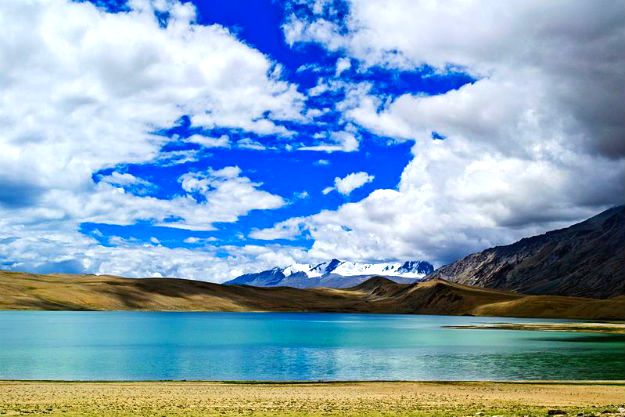Nature Places in Ladakh.Tsomoriri lake.
 Situated in Changthang plateau in south-east Ladakh, Tso Moriri or Lake Moriri is known for its scenic splendour. The high altitude lake is set between Ladakh in the north, Tibet in the east and Zanskar in the west. Tsomoriri along with Pangong Tso are two of the very popular high altitude lakes in Ladakh. At an elevation of 15,075 ft, it is the highest brackish water lake in India. Officially the lake is known as Tso Moriri Wetland Conservation Reserve and is accessible only during the summers as the region remains snowbound through rest of the year. The Changthang plateau is home to snowy peaks that feed the lake.
Situated in Changthang plateau in south-east Ladakh, Tso Moriri or Lake Moriri is known for its scenic splendour. The high altitude lake is set between Ladakh in the north, Tibet in the east and Zanskar in the west. Tsomoriri along with Pangong Tso are two of the very popular high altitude lakes in Ladakh. At an elevation of 15,075 ft, it is the highest brackish water lake in India. Officially the lake is known as Tso Moriri Wetland Conservation Reserve and is accessible only during the summers as the region remains snowbound through rest of the year. The Changthang plateau is home to snowy peaks that feed the lake.
Situated in Changthang plateau in south-east Ladakh, Tso Moriri or Lake Moriri is known for its scenic splendour. The high altitude lake is set between Ladakh in the north, Tibet in the east and Zanskar in the west. Tsomoriri along with Pangong Tso are two of the very popular high altitude lakes in Ladakh. At an elevation of 15,075 ft, it is the highest brackish water lake in India. Officially the lake is known as Tso Moriri Wetland Conservation Reserve and is accessible only during the summers as the region remains snowbound through rest of the year. The Changthang plateau is home to snowy peaks that feed the lake.
One stream comes from the north and another from the south-west and creates extensive marshes where they enter the lake. The lake had an outlet towards the south but it has contracted and now the lake is landlocked which has resulted in the lake to turn brackish. Salt used to be extracted from the lake by locals till 1959. The water of the lake is alkaline and is oligotrophic in nature, meaning it is home to organisms that are rich in nutrients.
Situated in Changthang plateau in south-east Ladakh, Tso Moriri or Lake Moriri is known for its scenic splendour. The high altitude lake is set between Ladakh in the north, Tibet in the east and Zanskar in the west. Tsomoriri along with Pangong Tso are two of the very popular high altitude lakes in Ladakh. At an elevation of 15,075 ft, it is the highest brackish water lake in India. Officially the lake is known as Tso Moriri Wetland Conservation Reserve and is accessible only during the summers as the region remains snowbound through rest of the year. The Changthang plateau is home to snowy peaks that feed the lake.
One stream comes from the north and another from the south-west and creates extensive marshes where they enter the lake. The lake had an outlet towards the south but it has contracted and now the lake is landlocked which has resulted in the lake to turn brackish. Salt used to be extracted from the lake by locals till 1959. The water of the lake is alkaline and is oligotrophic in nature, meaning it is home to organisms that are rich in nutrients.
As per the Himalayan Lakes Calssification, the Tso Moriri belongs to the category of remnant lakes which were originally structural but represent the remnants of vast lakes. The Changthang plateau, at 14,800 ft, is an extension of the Western Tibet plateau and it supports a low but diverse population of several animals. The lake is surrounded by the Rupshu valley which has hills rising to a height of 20,000 ft.
The main inhabitants of the area are Changpas, nomadic migratory shepherds who raise flocks of yak, sheep, goats and Tibetan horses. They engage in trade with caravans in the Ladakh region. They use the valley land for grazing their animals and for cultivation. If you want to stay near the shores of the lake then accommodation is available in Korzok village in tented camps which spring up every year during tourist season. These camps are moderately priced and offer good facilities.
Similar tented camps are available in Nubra Valley too. You can also stay at as a paying guest with locals. There is a guest house and a budget hotel too in Nubra Valley. You can also stay at the camps set up near the Pangong Lake which are are slightly costlier but better equipped than the ones located near Lake Moriri. It will be best to carry food and water along with you. The camps do provide food but having something extra to munch on, along the way is recommended. It is better to carry your own food in case the food served is not up to your standards. The locals serve home made food which is of good quality. The best time to visit Tsomoriri is from June to September. By the end of September, the tourist season comes to an end.
Hi! I am a robot. I just upvoted you! I found similar content that readers might be interested in:
http://www.india.com/travel/ladakh/places-to-visit/lakes-tsomoriri/
25.00% vote courtesy of @kirkins and the @dsnap project, send your bid to @dsnap.bot!